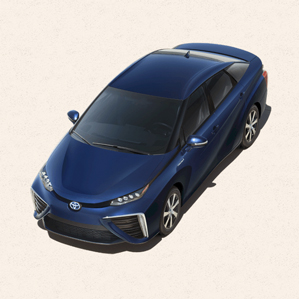Hybrids are a much more cost-effective way to reduce carbon emissions than newly released hydrogen fuel cell cars.
Why It MattersAbout a third of carbon dioxide emissions come from transportation.
The Toyota Mirai fuel cell vehicle. If you want to help cut greenhouse gas emissions, you should probably skip the hydrogen fuel cell cars now coming to market and buy a (much cheaper) hybrid instead. After decades of research and small-scale demonstrations, hydrogen cars are finally rolling into view. These vehicles use electric motors, but their electricity comes not from a battery but from hydrogen, processed in a chemical reaction that takes place inside a fuel cell. Researchers and engineers have greatly lowered the costs of fuel cells—by as much as 95 percent—in recent years. That, along with pressure to meet emissions regulations in California, means the technology is finally coming to market. Earlier this year, Hyundai started leasing hydrogen-powered Tucson Fuel Cell SUVs in California. Toyota plans to launch a newly designed compact hydrogen car called the Mirai in Japan this month and in the U.S. next year. Meanwhile, GM, Honda, and others are developing their own hydrogen vehicles. Carmakers are keen to extol the environmental credentials of these new models. Hyundai advertises that its cars emit no carbon dioxide, while Toyota boasts that its hydrogen cars “leave nothing behind but water.” But these ads are a little misleading. The only thing that comes out of the cars’ tailpipes is, indeed, water vapor, but the hydrogen they run on is mostly made from natural gas via a process that releases significant amounts of greenhouse gases into the atmosphere. Fuel cells are still greener than some conventional cars. Based on an analysis by the Union of Concerned Scientists, producing hydrogen from natural gas for the Hyundai Tucson Fuel Cell vehicle emits about as much carbon dioxide as a car that gets 38 miles per gallon. That’s far better than the gasoline-powered version of the Tucson, which gets 25 miles per gallon. But you can buy a number of cars that get better than 38 miles per gallon. That’s relatively easy to do with small cars. But even the hybrid Toyota Prius v, which is slightly roomier than the Tucson, gets 42 miles per gallon. And it’s far cheaper than the Tucson Fuel Cell vehicle. The Tucson Fuel Cell leases for about $499 per month, which includes the cost of hydrogen fuel. In some areas, you can lease a Prius v for $159 per month. Emerging technologies for producing hydrogen could eventually make fuel-cell cars cleaner and cheaper. For example, hydrogen can be made using renewable sources of electricity to power an electrolyzer, which splits water into its constituent hydrogen and oxygen atoms. The problem is that this is still far more costly than making hydrogen from natural gas. Longer term, instead of using solar power to generate electricity, and then using that electricity to split water, it may be possible to engineer catalysts to absorb sunlight and use its energy to split water. That would make hydrogen generation simpler and cheaper. But for now, the main advantage of hydrogen cars over electric cars is that they can be recharged more quickly. Even the fastest chargers available— for the Tesla Model S—take about 20 minutes to add 130 miles of charge. You can fill a Hyundai’s hydrogen tank, which holds enough for 265 miles, in 10 minutes. Quick refills would be more convenient for long road trips. On the other hand, while there are plans to install 40 public hydrogen-fueling stations next year—mainly as a result of investment by the California government and some automakers—right now there are still only three public hydrogen stations in the entire United States. |

Nenhum comentário:
Postar um comentário
Observação: somente um membro deste blog pode postar um comentário.